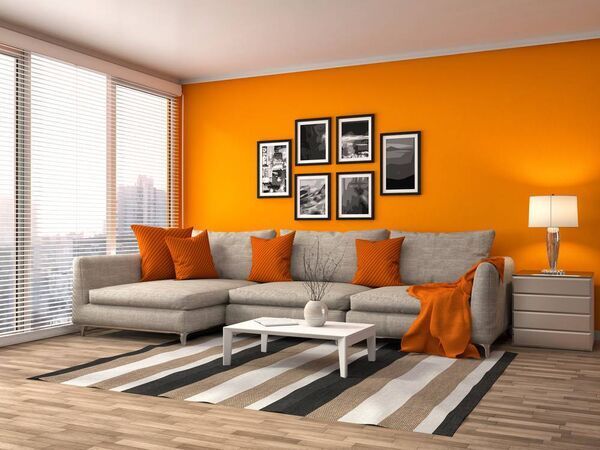Introduction
When it comes to choosing colors for our interior walls, we often consider not only the aesthetic appeal but also the emotional impact they can have on our moods. Colors have the power to evoke various emotions and can greatly influence our overall well-being. In this article, we will explore some of the most popular colors that are known to create happy moods on interior walls.
 Sunny Yellow
Sunny Yellow
Sunny yellow, with its bright and vibrant hue, is a popular choice for creating a happy and positive mood in interior spaces. Here are some key points about using sunny yellow on interior walls:
Psychological Impact: Yellow is often linked to happiness, joy, and energy. It’s a color that can stimulate and uplift the mood. This makes it ideal for spaces where you want to induce a sense of optimism and cheerfulness.
Best Rooms for Sunny Yellow: This color works wonderfully in rooms where you want to create a welcoming and lively atmosphere. The kitchen is a great choice as it’s the heart of the home where families often gather. Living rooms can also benefit from the warmth of sunny yellow, creating a space that feels inviting and vibrant. Children’s playrooms are another excellent area for this color, as it can stimulate playfulness and creativity.
Shades and Tones: Sunny yellow comes in various shades, from soft pastels to more vivid, electric hues. The choice of shade can significantly impact the room’s atmosphere. Lighter, pastel yellows can create a more soothing yet cheerful environment, while brighter yellows add energy and dynamism.
Complementary Colors: Yellow pairs well with various colors, allowing for versatile design options. It can be combined with whites or creams for a fresh, airy feel. To create more dynamic spaces, pairing yellow with contrasting colors like blues or purples can be effective. For a harmonious look, using shades of green alongside yellow can be very pleasing to the eye.
Lighting Considerations: Natural and artificial light can affect how sunny yellow is perceived in a room. In rooms with ample natural light, yellow can feel brighter and more vibrant, while in spaces with less light, it might appear softer and more subdued.
Decorating Tips: When using sunny yellow, it’s important to balance it with other elements in the room. Too much yellow can be overwhelming, so incorporating neutral tones in furniture or decor can help moderate the intensity. Textures and patterns can also play a crucial role in breaking up the expansiveness of the color and adding visual interest.
Emotional Response: Finally, it’s worth noting that while yellow is generally uplifting, its impact can vary from person to person. Some may find certain shades of yellow to be overly stimulating or even anxiety-inducing. Therefore, it’s important to consider the specific shade of yellow and the context of the room when deciding to use this color.
Sunny yellow is a fantastic color for creating a cheerful, energetic, and welcoming environment in your home. Its versatility in terms of shades and compatibility with other colors makes it a popular choice for various interior spaces.
 Calming Blue
Calming Blue
The use of color in interior design is a powerful tool for influencing mood and atmosphere in a space. Blue, in particular, is known for its calming and soothing effects, making it a popular choice for creating a serene environment. Here’s more detail about how blue can be used to create happy moods in interior spaces:
Sense of Tranquility: Blue, especially in its lighter shades, is often associated with tranquility and calmness. It’s reminiscent of the sky and sea, elements that are universally seen as peaceful and serene. This makes blue an excellent choice for rooms where relaxation and unwinding are priorities, such as bedrooms and bathrooms.
Variety of Shades: Blue comes in a wide range of shades, each evoking different feelings and atmospheres. Lighter blues like sky blue or baby blue tend to evoke a sense of serenity and open space, mimicking the calming effect of looking into a clear sky. These shades are subtle and can make a room feel more spacious and airy.
Energetic and Refreshing Tones: On the other end of the spectrum, brighter and more saturated blues like turquoise or teal can infuse energy into a space. These shades are more vibrant and can bring a refreshing pop of color to a room. They are great for accent walls or decorative elements, especially in spaces like living rooms or kitchens where a more lively atmosphere is desired.
Versatility in Design: Blue is also a very versatile color in interior design. It pairs well with a variety of other colors, from warm tones like yellows and oranges to cool tones like greys and whites. This flexibility allows blue to be used in a wide range of design styles, from modern and minimalist to traditional and cozy.
Psychological Effects: Psychologically, blue is often seen as a color that promotes intellectual thought and concentration, in addition to its calming effects. This makes it a good choice for studies or home offices, where focus and calmness are needed.
Cultural Associations: It’s also important to consider the cultural connotations of blue, which can vary. In many Western cultures, blue is seen as a color representing stability and trust, which can make it a comfortable choice for communal areas.
Calming Blue versatility in shade and tone, combined with its psychological effects, makes it an ideal choice for creating happy, calming moods in interior spaces. Whether aiming for a tranquil retreat or a lively social area, there’s a shade of blue that can help achieve the desired mood and aesthetic.
 Cheerful Orange
Cheerful Orange
The use of cheerful orange in interior walls is a popular choice for creating a happy and vibrant mood in a room. Here’s a more detailed explanation:
Warmth and Vibrancy: Orange is inherently a warm color, which means it has the ability to make a space feel more inviting and cozy. This warmth can create a sense of comfort and can be particularly appealing in rooms where you want to encourage relaxation and casual interaction.
Stimulating Conversation and Social Interaction: The vibrancy of orange makes it a great choice for rooms where social interaction is key. It’s a stimulating color that can help to encourage conversation and liveliness. This makes it a popular choice for areas like the dining room or a living room, where people gather and socialize.
Association with Creativity: Orange is often linked with creativity and playfulness. Using this color in a home office or a creative workspace can inspire and boost creativity. It’s believed to stimulate the mind, making it easier to think of new ideas or solutions.
Shades of Orange: There are various shades of orange that can be used depending on the desired effect and the existing decor of a room. Lighter shades like peach offer a more subtle and soft look, creating a gentle, welcoming atmosphere. Brighter shades like tangerine are more energetic and bold, making a strong statement and bringing a lot of energy to a space.
Combining with Other Colors: Orange can be effectively paired with other colors to either tone it down or enhance its vibrancy. It pairs well with neutral shades like white, beige, or grey for a balanced look. For a more dynamic and contrasting effect, it can be paired with blues or greens.
Psychological Effects: Like all colors, orange can have psychological effects on people. It’s often associated with happiness, enthusiasm, and energy. These attributes make it an excellent choice for rooms where you want to evoke positivity and a lively atmosphere.
The use of cheerful orange in interior design is a versatile and effective way to create a happy and stimulating environment. Whether you choose a soft peach for a gentle ambiance or a bold tangerine for a more energetic vibe, this color can significantly influence the mood and atmosphere of a space.
 Refreshing Green
Refreshing Green
The color green, particularly in shades like mint or sage, is a popular choice for creating happy and calming moods in interior spaces. Here’s a detailed explanation of why green is effective for this purpose:
Association with Nature: Green is strongly associated with nature, which is often linked to feelings of peace and rejuvenation. By bringing this color into your home, you can create a sense of bringing the outdoors inside, fostering a connection with the natural world.
Refreshing Quality: Green has a refreshing quality that can breathe new life into a room. It’s reminiscent of the fresh leaves of spring or the tranquility of a lush forest, which can have a soothing effect on the mind and body.
Balance and Harmony: Green is considered a balanced color, sitting in the middle of the color spectrum. It can create a sense of equilibrium in a room, promoting both physical and mental well-being.
Variety of Shades: The versatility of green means there’s a shade for almost every mood and setting. Mint green, with its light and airy feel, can create a sense of spaciousness and lightness, ideal for smaller or darker rooms. Sage green, being more subdued, can bring an elegant and calming presence, suitable for areas of relaxation like bedrooms and living rooms.
Promotes Relaxation: Green is known to have a calming effect, making it ideal for spaces where relaxation is a priority. It’s a color that can help reduce stress and promote a sense of well-being.
Versatility in Design: Green can complement a wide range of interior styles, from modern and minimalist to rustic and traditional. It pairs well with natural materials like wood and stone, as well as with both neutral and bold color palettes.
Positive Psychological Effects: Various studies suggest that green has positive psychological effects, such as reducing anxiety and improving mood. This makes it a particularly good choice for creating a happy and serene atmosphere in your home.
Using green on interior walls can create a refreshing, balanced, and harmonious environment. Its connection to nature and range of shades makes it a versatile and effective choice for enhancing the mood and aesthetic of a space.
 Uplifting Pink
Uplifting Pink
Pink, especially in its lighter shades like blush or pastel, is a popular color for creating a happy mood in interior walls due to its association with love, compassion, and nurturing. This color can impart a sense of warmth and tenderness, which makes it an ideal choice for spaces where comfort and relaxation are desired, such as bedrooms and nurseries. The psychological impact of pink is significant in interior design:
Emotional Influence: Pink is believed to have a calming effect on emotions, potentially reducing feelings of anger and aggression. This makes it a suitable choice for rooms where peace and tranquility are priorities.
Versatility: The range of pink shades offers versatility in design. Light pinks like blush or pastel can create a soft, romantic atmosphere, ideal for personal spaces or areas meant for relaxation. These lighter pinks are often used to create a serene and nurturing environment.
Energy and Playfulness: On the other end, brighter pinks like fuchsia can inject energy and playfulness into a space. Such vibrant shades are excellent for areas where creativity, play, or dynamic interaction are encouraged, like children’s rooms or creative studios.
Complementary Color Schemes: Pink pairs well with numerous other colors. For a more subtle and sophisticated palette, it can be combined with whites, greys, or soft metallics. For a more vibrant and energetic space, pairing pink with contrasting colors like green or blue can be very effective.
Cultural and Personal Perceptions: It’s important to consider personal and cultural perceptions of color. While pink is often associated with femininity in many Western cultures, it’s also gaining popularity as a trendy and inclusive color choice in modern interior design, regardless of gender stereotypes.
The use of pink in interior design, especially for wall colors, can significantly influence the mood and atmosphere of a space. Its ability to evoke feelings of love, warmth, and comfort, as well as its versatility in creating both calm and energetic environments, makes it a popular choice in creating happy and uplifting moods in interiors.
 Energetic Red
Energetic Red
The color red is a bold and vibrant choice for interior walls, particularly when the goal is to create an atmosphere of energy and happiness. Here’s more about using red in interior design:
Emotional Impact: Red is known for its ability to evoke strong emotions. It’s linked to passion, excitement, and energy. This makes it an excellent choice for rooms where you want to stimulate conversation and interaction, such as living rooms or dining areas.
Use in Specific Areas: While red can be too stimulating for bedrooms or spaces meant for relaxation, it’s ideal for areas where you want to induce a sense of energy. For instance, a red accent wall in a dining room can create a lively, sociable atmosphere, and in a home gym, it can energize and motivate.
Accent Color: Red works exceptionally well as an accent color. Instead of painting all the walls in a room red, you might choose one wall to paint red and keep the others in more neutral tones. This approach can create a focal point and add a burst of energy without overwhelming the space.
Combination with Neutrals: To balance the intensity of red, it’s often paired with neutral colors like white, grey, or black. These combinations can create a visually appealing and more harmonized space. For example, red walls with white trim can look striking and modern.
Variations of Red: There are many shades of red, from deep burgundy to bright cherry red. The choice of shade can significantly affect the mood of the room. A darker red can feel more sophisticated and cozy, while a brighter red can be more energizing and vibrant.
Texture and Materials: The impact of red can also be influenced by the texture and materials used in the room. Glossy reds can feel more modern and energetic, while matte finishes might lend a more subdued and elegant vibe.
Lighting Considerations: Lighting can significantly impact how red is perceived in a room. Natural light can make red feel more vibrant, while artificial light can either enhance or mute the color, depending on the type of bulbs used.
Cultural and Personal Associations: It’s also important to consider personal and cultural associations with the color red, as these can influence how people respond to the space.
By considering these factors, red can be effectively incorporated into interior design to create spaces that are both energizing and aesthetically pleasing.
Conclusion
Choosing the right colors for your interior walls can have a significant impact on the overall mood and atmosphere of your space. Whether you prefer sunny yellow for a cheerful ambiance, calming blue for a peaceful retreat, or any other color that resonates with you, it’s important to consider the emotional impact they can have. Experiment with different colors and find the perfect combination that brings happiness and positivity to your home.
Frequently Asked Questions
Decode the magic of gardens with our guide to Landscaping Styles Frequently Asked Questions.
- The best way to choose a color scheme for your living room is to start with a source of inspiration, such as a piece of art, a rug, or even a favorite fabric. Look for colors that you’re naturally drawn to and consider how they will interact with the natural light in your room. Think about the mood you want to create – calming, energizing, cozy – and choose colors that support this mood. It’s also important to consider how the colors will flow with the rest of your home.
- To make a small room appear larger, use light colors on the walls and floor, as they make a space feel more open and airy. Incorporating mirrors can also create the illusion of more space by reflecting light and the interior of the room. Keep the room clutter-free and choose furniture that is proportional to the size of the room. Using multi-functional furniture can also save space. Lastly, ensure good lighting, as dark rooms tend to feel smaller.
- Lighting is crucial in interior design because it not only illuminates the space but also enhances the room’s mood and ambiance. Different types of lighting – ambient, task, and accent – serve different purposes. Ambient lighting provides overall illumination, task lighting is used for specific activities like reading, and accent lighting highlights architectural features or artwork. The right lighting can transform a room, making it feel warm and inviting, spacious, or cozy.
- When choosing a rug size, consider the room’s layout and the furniture placement. In a living room, a common rule is that the front legs of all the main seating pieces should be on the rug to tie the arrangement together. In a dining room, the rug should be large enough for chairs to be pulled out without catching on the edge. In a bedroom, the rug should extend around 18-24 inches beyond the sides of the bed to provide a warm landing in the morning. Make sure the rug is proportional to the space and doesn’t overwhelm or get lost in the room.
Recent Posts
- Modern Mural Ideas Transforming Walls into Artworks
- Thematic Table Decor Dressing Your Table for Special Occasions
- Festive Lighting Ideas Brightening Your Home for the Holidays
- Biodegradable Decor Materials Choosing Earth-Friendly Options
- Personalized Space Decor Making Your Home Uniquely Yours
- New Year’s Eve Decor Ringing in the New Year in Style
- Transforming Junk into Decor Upcycling at Its Best
- Second-Life Decor Objects Giving Old Items New Purpose
- Unique Decoration Crafting Standout Ideas for Your Home
- Environmentally Friendly Styling Decor with a Conscience















